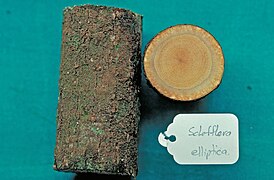Heptapleurum ellipticum
 From Wikipedia the free encyclopedia
From Wikipedia the free encyclopedia
| Climbing umbrella tree | |
|---|---|
 | |
| Scientific classification | |
| Kingdom: | Plantae |
| Clade: | Tracheophytes |
| Clade: | Angiosperms |
| Clade: | Eudicots |
| Clade: | Asterids |
| Order: | Apiales |
| Family: | Araliaceae |
| Genus: | Heptapleurum |
| Species: | H. ellipticum |
| Binomial name | |
| Heptapleurum ellipticum | |
| Synonyms[3] | |
Heptapleurum ellipticum, commonly known in Australia as the climbing umbrella tree, is a plant in the family Araliaceae native to the Indian subcontinent, Indochina, Malesia, Papuasia and Australia.
Description[edit]
The climbing umbrella tree is a vine or scandent shrub growing up to 10 m (33 ft) high and a stem diameter of up to 9 cm (3.5 in).[4][5]
The alternately arranged leaves have a petiole measuring 4 to 14 cm (1.6 to 5.5 in) long.[4][5][6] They are compound with 4 to 7 leaflets arranged palmately.[5] Each leaflet measures around 6 to 18 cm (2.4 to 7.1 in) long by 2.5 to 10 cm (0.98 to 3.94 in) wide.[4][5][6] They are leathery and glabrous with usually 5-6 pairs of secondary veins.[6]
The inflorescence is about 24 cm (9.4 in) long,[4][6] with flowers arranged in umbels. The globose fruit are very small, about 4–6 mm (0.16–0.24 in) in diameter.[4][6]
Taxonomy[edit]
This species was first described as Sciodaphyllum ellipticum in 1826 by the Dutch botanist Carl Ludwig Blume, based on material collected near Mount Salak, Indonesia.[7] In 1865 it was transferred to the genus Heptapleurum by Berthold Carl Seemann,[8] then to Schefflera by Hermann Harms in 1894,[9] where it remained for more than a century. In 2020 Porter P. Lowry II and Gregory M. Plunkett published a paper in which they resurrected the genus Heptapleurum and transferred a large number of species − including this one − to it from Schlefflera.[10]
Distribution and habitat[edit]
The natural range of the climbing umbrella tree is from India through Southeast Asia and Southern China, Melanesia, Papuasia, Christmas Island and northern Australia.[3][4][5] In Australia it is restricted to the northeastern parts of Queensland.[4][11] It grows in mainly in rainforest and gallery forest from near sea level up to 2,500 m (8,200 ft).[4][5][6]
Uses[edit]
The plant has been used in traditional medicine as a treatment for a number of ailments, including coughs, edema, toothache and wounds.[5]
Gallery[edit]
- Foliage
- Fruit
- Stems coiled on the ground
- Cross section of stem
References[edit]
- ^ "Species profile—Heptapleurum ellipticum". Queensland Department of Environment and Science. Queensland Government. 2022. Retrieved 25 March 2023.
- ^ Li, R.; Qin, h.; Botanic Gardens Conservation International (BGCI).; IUCN SSC Global Tree Specialist Group. (2019). "Heptapleurum ellipticum". IUCN Red List of Threatened Species. 2019: e.T144056634A147644168. doi:10.2305/IUCN.UK.2019-2.RLTS.T144056634A147644168.en. Retrieved 20 February 2023.
- ^ a b c "Heptapleurum ellipticum (Blume) Seem". Plants of the World Online. Royal Botanic Gardens, Kew. Retrieved 20 February 2023.
- ^ a b c d e f g h F.A.Zich; B.P.M.Hyland; T.Whiffen; R.A.Kerrigan (2020). "Heptapleurum ellipticum". Australian Tropical Rainforest Plants Edition 8 (RFK8). Centre for Australian National Biodiversity Research (CANBR), Australian Government. Retrieved 20 February 2023.
- ^ a b c d e f g "Heptapleurum ellipticum (Blume) Seem". Flora and Fauna Web. Singapore Government. Retrieved 25 March 2022.
- ^ a b c d e f "Schefflera elliptica (Blume) Harms in Engl. & Prantl, Nat. Pflanzenfam. 3(8): 39. 1894". Flora of China (eFloras). Missouri Botanical Garden, St. Louis, MO & Harvard University Herbaria, Cambridge, MA. Retrieved 20 February 2023.
- ^ Blume, Carl Ludwig (1825). Bijdragen tot de flora van Nederlandsch Indië. Vol. 15. Batavia. p. 878.
- ^ "Heptapleurum ellipticum". International Plant Names Index (IPNI). Royal Botanic Gardens, Kew. 2021. Retrieved 25 March 2023.
- ^ "Schlefflera elliptica". International Plant Names Index (IPNI). Royal Botanic Gardens, Kew. 2021. Retrieved 25 March 2023.
- ^ Porter P. Lowry II; Gergory M. Plunkett (2020). "Resurrection of the Genus Heptapleurum for the Asian Clade of Species Previously Included in Schefflera (Araliaceae)". Novon: A Journal for Botanical Nomenclature. 28 (3): 143–170. doi:10.3417/2020612. S2CID 221860194.
- ^ "Search: species: Heptapleurum ellipticum | Occurrence records". Australasian Virtual Herbarium. Australian Government. Retrieved 25 March 2023.
External links[edit]
 Data related to Heptapleurum ellipticum at Wikispecies
Data related to Heptapleurum ellipticum at Wikispecies Media related to Heptapleurum ellipticum at Wikimedia Commons
Media related to Heptapleurum ellipticum at Wikimedia Commons- View a map of historical sightings of this species at the Australasian Virtual Herbarium
- View observations of this species on iNaturalist
- View images of this species on Flickriver




